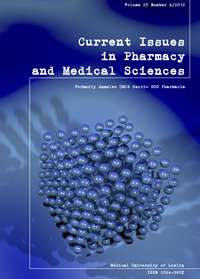Analysis of expression profile of genes encoding cell adhesion proteins in endometrial cancer
DOI:
https://doi.org/10.12923/j.2084-980X/25.4/a.25Keywords:
endometrial cancer, expression profile of genes, adhesion proteinsAbstract
Endometrial cancer is one of the most common gynecological malignancies. Unfortunately, molecular pathogenesis of this neoplasm remains poorly understood. Using MacroArray technique, we analyzed expression profile of genes encoding adhesion proteins in neoplastic tissue derived from 40 patients diagnosed with the endometrial cancer between 2003 and 2004. Analysis of statistic dependences between gene expression profiles and tumor grade pointed out thirteen genes encoding adhesion proteins (cadherin-1, -5, -8, -13, -15, integrin alpha-1, -6, integrin beta-1, -8, zyxin related protein-1, paxillin, catenin alpha-1), which are significantly over- or under-expressed (11 and 2 genes respectively) depending of tumor grade. Taking under consideration clinical stage of the cancer we pointed out eleven genes (integrin alpha-8, integrin beta-1, -3, cadherin-8, -15, catenin beta-1, paxillin, trombospondin-2, ninjurin-1, desmocollin-3) encoding proteins crucial for cell-cell interaction those expressions were altered showing statistically significance for different clinical stage according to FIGO classification.
References
1. Aijaz S., Balada M.S., Matter K.: Tight junction: molecular architecture and function. Int. Rev. Cytol., 248, 261, 2006.
2. Beckerle M.C.: Zyxin: zinc fingers at sites of cell adhesion. BioEssays, 19, 949, 1997.
3. Blaschuk O.W., Devemy E.: Cadherins as novel targets for anti-cancer therapy. Eur. J. Pharmacol., 625, 195, 2009.
4. Cavallaroa U., Liebnerd S., Dejana E.: Endothelial cadherins and tumor angiogenesis. Exp. Cell Res., 312, 659, 2006.
5. Degenhardt Y., Silverstein S.: Interaction of zyxin, a focal adhesion protein, with the E6 protein from human papillomavirus type 6 results in its nuclear translocation. J. Virol., 75, 11791, 2001.
6. Dejana E.: Endothelial cell–cell junctions: happy together. Nat. Rev. Mol. Cell Biol., 5, 261, 2004.
7. Dudka J. et al.: Different effects of resveratrol on dose related doxorubicin-induced heart and liver toxicity. Evid. Based Complement. Alternat. Med. 2012, 606183, 2012.
8. Dudka J. et al.: Intensification of doxorubicin-related oxidative stress in the heart by hypothyreosis is not related to the expression of cytochrome P450 NADPH-reductase, inducible nitric oxide synthase and xanthine oxidase activity. Oxid. Med. Cell. Longev. 2012, 139327, 2012.
9. Dudka J. et al.: The diagnosis of anthracycline-induced cardiac damage and heart failure. Postepy Hig. Med. Dosw., 63, 225, 2009.
10. Fujimoto N. et al.: Cloning and characterization of androgen receptor coactivator, ARA55, in human prostate. J. Biol. Chem., 274, 8316, 1999.
11. Gumbiner B.M.: Regulation of cadherin-mediated adhesion in morphogenesis, Nat. Rev. Mol. Cell Biol., 6, 622, 2005.
12. Hecht J.L., Mutter G.L.: Molecular and pathologic aspects of endometrial carcinogenesis. J. Clin. Oncol., 24, 4783, 2006.
13. Hulit J. et al.: N-cadherin signaling potentiates mammary tumor metastasis via enhanced extracellular signal-regulated kinase activation. Cancer Res., 67, 3106, 2007.
14. Jeanes A., Gottardi C.J., Yap A.: Cadherins and cancer: how does cadherin dysfunction promote tumor progression? Oncogene, 27, 6920, 2008.
15. Korga et al.: The redox imbalance and the reduction of contractile protein content in rat hearts andministered with l-thyroxine and doxorubicine. Oxid. Med. Cell. Longev., 2012, 681367, 2012.
16. Kottke M.D., Delva E., Kowalczyk A.P.: The desmosome: cell science lessons from human diseases. J. Cell Sci., 797, 119, 2006.
17. Lee J.W. et al.: Two classes of proteins dependent on either the presence or absence of thyroid hormone for interaction with the thyroid hormone receptor. Mol. Endocrinol., 9, 243, 1995.
18. Lewin S.N.: Revised FIGO staging system for endometrial cancer. Clin. Obstet. Gynecol., 54, 215, 2011.
19. Ryan A.J. et al.: Endometrial cancer. Cell Tissue Res., 322, 53, 2005.
20. Schaller M.D.: Paxillin: a focal adhesion-associated adaptor protein. Oncogene, 20, 6459, 2001.
21. Śliwińska J. et al.: Tirapazamine-doxorubicyn interaction referring to heart oxidative stress and Ca2+ balance protein levels. Oxid. Med. Cell. Longev. 2012; 890826, 2012.
22. Tomita K. et al.: Cadherin switching in human prostate cancer progression. Cancer Res., 60, 3650, 2000.
23. Van Roy F., Berx G.: The cell–cell adhesion molecule E-cadherin. Cell. Mol. Life Sci., 65, 3756, 2008.
24. Yagi T., Takeichi M.: Cadherin superfamily genes: functions, genomic organization, and neurologic diversity. Genes Dev., 14, 1169, 2000.
25. Yang L. et al.: Interaction of the tau2 transcriptional activation domain of glucocorticoid receptor with a novel steroid receptor coactivator, Hic-5, which localizes to both focal adhesions and the nuclear matrix. Mol. Biol. Cell, 11, 2007, 2000.
Downloads
Published
Issue
Section
License
Copyright (c) 2012 Author

This work is licensed under a Creative Commons Attribution-NonCommercial-NoDerivatives 3.0 Unported License.


